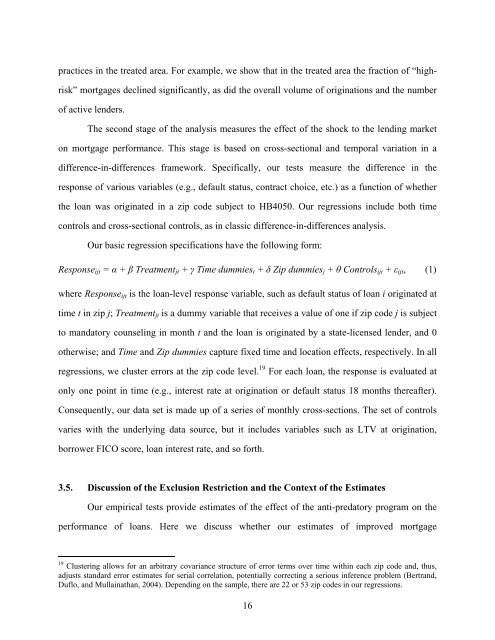You also want an ePaper? Increase the reach of your titles
YUMPU automatically turns print PDFs into web optimized ePapers that Google loves.
practices in the treated area. For example, we show that in the treated area the fraction of “highrisk”<br />
mortgages declined significantly, as did the overall volume of originations and the number<br />
of active lenders.<br />
The second stage of the analysis measures the effect of the shock to the lending market<br />
on mortgage performance. This stage is based on cross-sectional and temporal variation in a<br />
difference-in-differences framework. Specifically, our tests measure the difference in the<br />
response of various variables (e.g., default status, contract choice, etc.) as a function of whether<br />
the loan was originated in a zip code subject to HB4050. Our regressions include both time<br />
controls and cross-sectional controls, as in classic difference-in-differences analysis.<br />
Our basic regression specifications have the following form:<br />
Response ijt = α + β Treatment jt + γ Time dummies t + δ Zip dummies j + θ Controls ijt + ε ijt , (1)<br />
where Response ijt is the loan-level response variable, such as default status of loan i originated at<br />
time t in zip j; Treatment jt is a dummy variable that receives a value of one if zip code j is subject<br />
to mandatory counseling in month t and the loan is originated by a state-licensed lender, and 0<br />
otherwise; and Time and Zip dummies capture fixed time and location effects, respectively. In all<br />
regressions, we cluster errors at the zip code level. 19 For each loan, the response is evaluated at<br />
only one point in time (e.g., interest rate at origination or default status 18 months thereafter).<br />
Consequently, our data set is made up of a series of monthly cross-sections. The set of controls<br />
varies with the underlying data source, but it includes variables such as LTV at origination,<br />
borrower FICO score, loan interest rate, and so forth.<br />
3.5. Discussion of the Exclusion Restriction and the Context of the Estimates<br />
Our empirical tests provide estimates of the effect of the anti-predatory program on the<br />
performance of loans. Here we discuss whether our estimates of improved mortgage<br />
19 Clustering allows for an arbitrary covariance structure of error terms over time within each zip code and, thus,<br />
adjusts standard error estimates for serial correlation, potentially correcting a serious inference problem (Bertrand,<br />
Duflo, and Mullainathan, 2004). Depending on the sample, there are 22 or 53 zip codes in our regressions.<br />
16

















